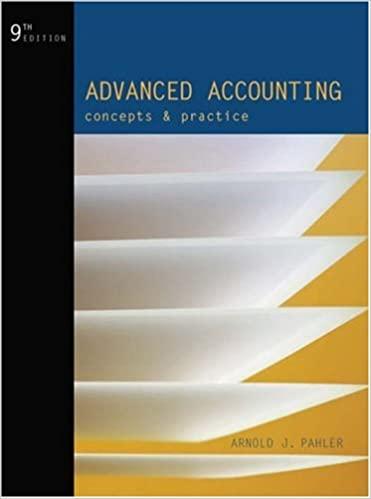Assessing a Newly Created Subsidiarys Performance Data for Pola Inc., which operates a large re tail store,
Question:
Assessing a Newly Created Subsidiary’s Performance Data for Pola Inc., which operates a large re¬
tail store, for the year ended 12/31/05 (its tenth year of business) follow:
Operating income . $ 160,000 Interest expense . (40,000)
Income before Income Taxes . 120,000 Income tax expense @ 40% . (48,000)
Net Income . $ 72,000 Current liabilities (beginning, average, and ending balances) . 200,000 Long-term debt, 10% (beginning, average, and ending balances) . 400,000 Stockholders' equity (beginning, average, and ending balances) . 400,000'
Total Liabilities and Equity . $1,000,000 Revenues . $1,600,000 During 2005, Pola took steps to open a new store, which opened for business on 1/1/06. Data for the new store’s quarter endtd 3/31/06 follow:
Liabilities (beginning, average, and ending balances) . $200,000 Revenues . 400,000 Income for the quarter {after allocations), as reported to Pola . 48,000 Additional Information 1. Financing. To finance the new store, on 1/1/06, Pola
(a) issued 10,000 shares of its common stock, thus raising $200,000 and
(b) borrowed $800,000 at 12% interest, due in five years.
This debt is recorded on Pola’s books.
2. Form of organization. To legally insulate the new store, Pola
(a) created a 100%-owned sub¬
sidiary, Sola Inc., and
(b) invested the $1,000,000 of capital in Sola.
3. Use of proceeds. Sola used the $1,000,000 to acquire fixed assets ($700,000), acquire inven¬
tory ($250,000), and provide working capital ($50,000) for the new store. Sola’s fixed assets are pledged as collateral on the $800,000, 12% loan.
4. Inventory purchases. Pola’s purchasing department buys inventory for Sola. All inventory ship¬
ments to Sola were billed to Sola at Pola’s cost.
5. Fixed assets. Sola’s store has the same square footage of retail space as Pola. For each loca¬
tion, the land and building are owned. Pola’s fixed assets have a fair value of $200,000 more than their book value of $450,000.
6. Annual audit cost. For 2005, the annual audit by the company’s outside auditors cost $20,000.
For 2006, the cost of the audit will be approximately $24,000. The $4,000 increase is entirely attributable to having the new location. Pola’s interim reporting policy is to spread its audit cost over the four quarters. Accordingly, Pola expensed $6,000 on its books for the first quar¬
ter of 2006, of which $1,000 was allocated to Sola.
7. Corporate charges. The only other expenses recorded on Pola’s books that were charged or al¬ located to Sola were for insurance ($16,000) and advertising ($7,000). The insurance expense (an mcremental cost) was directly traceable to Sola. On a standalone basis. Sola’s insurance would cost $21,000 (thus a $5,000 reduction because this is for a second location). The ad¬
vertising allocation was a proration based on square footage of retailing space for the two lo¬ cations.
8. Sola’s expenses. Expenses incurred directly at the subsidiary level, such as employee salaries, payroll taxes, and utilities, were expensed on Sola’s books.
9. Depreciation. Both entities use the double-declining-balance method.
idated income tax return.
Required 1. ROE and BEP for Pola. Make a return on equity (ROE) calculation and a basic earning power (BEP) calculation (operating income/total assets) for Pola for 2005 to be used as a standard in evaluating Sola’s profitability. Eor the ROE calculation, use the beginning-of-year balance in the denominator for simplicity (rather than an average balance).
2. ROE and BEP for Sola. Make the same two calculations for Sola for the first quarter of 2006.
One of the objectives here is to enable Pola to evaluate its investment in Sola from the perspec¬
tive of an investor in the same manner that stockholders evaluate a company’s performance from their unique perspective. (Prom Pola’s perspective, the ROE calculation for Sola is the same as the annual return on investment [AROI] calculation discussed in Chapter 2.)
3. ROTC. In annually evaluating the profitability of companies, analysts use a return on “total”
capital calculation (as done by both Forbes and Business Week) in addition to the ROE calcu¬
lation. Total capital includes long-term debt and preferred stock (as well as common stock).
Make this calculation for Pola and Sola.
4. ROA. Make a return on asset (ROA) calculation for both entities. Is this calculation of any value? Why or why not?
5. Manner of handling the new debt. Can you think of two other ways in which the $800,000 bank borrowing and cash transfer to Sola could have been recorded or handled? Does it mat¬
ter whether the debt is recorded on the parent’s or the subsidiary’s books?
6. Evaluation. Using the percentages calculated for requirements 1 and 2, evaluate the new store relative to the old store. Can you think of other items that should be considered in making this comparison? Was opening the new store worthwhile? To which store manager would you give a cash bonus?
7. Separate statements. If Sola were to issue separate financial statements for whatever reason, what reporting issues would arise? What special disclosures would be needed?
Step by Step Answer:






